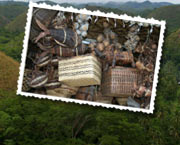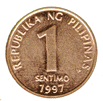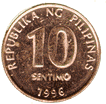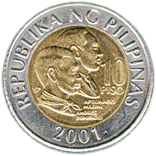Philippine Coins
IJsselstein, Friday, 3 May 2002 (updated: Sunday, 25 September 2005)
| In the Philippines, coins of 1, 5, 10, and 25 centavos (officially called sentimo), and 1, 5 and 10 pesos (officially piso) are in use. All older coins have been demonetized, and cannot be used anymore.
You will probably never see the one centavo coin for real, as they are very difficult to find (slightly over 18 million have been made, that is less than one for every four Filipinos), and also pretty useless, due to their low value, which is probably a world record for a coin still being minted. The five-centavo coin is exactly the same size as the one-centavo coin, but actually has less metal, due to the hole. This coin is also not very useful, and sometimes seen as decoration on key-rings, or used as emergency washers. The the smallest coin you'll actually find in common use is the twenty-five centavo coin. The one peso coin, most common of all, depicts the national hero Josť Rizal, and the five peso coin freedom fighter Emilio Aguinaldo. The bimetallic ten peso coin was introduced in 2000, and is not yet (in 2005) in wide circulation, although it is getting more common, and I have seen the first vending machines accepting it. This coin shows the freedom fighters Apolinario Mabini and Andres Bonifacio. Note that the same heroes also appeared on the (former) bank notes of the same value. You can buy collectible (old and new) Philippine coins and notes directly from the Bangko Sentral ng Pilipnas. An interesting blog on Philippine money is on blogspot. For those interested, I've added some pictures of old Spanish-Philippines coins and US-Philippines coins to this site. |
| Denomination | Composition |
| 10 Piso | Ring: 75% Copper; 25% Nickel
Core: 92% Copper; 6% Aluminum; 2% Nickel |
| 5 Piso | 70% Copper; 24.5% Zinc; 5.5% Nickel |
| 1 Piso | 75% Copper; 25% Nickel |
| 25 Sentimo | 65% Copper; 35% Zinc |
| 10 Sentimo | 6% Copper; 94% Steel |
| 5 Sentimo | 6% Copper; 94 % Steel |
| 1 Sentimo | 6% Copper; 94% Steel |
For those interested in how the Peso came to be, I'll give a passage from The Philippines: Past and Present by Dean C. Worcester (published in 1914), Volume I, pages 347-350:
|
Another fundamentally important aid to the commercial development of the islands was afforded by a radical reformation of the currency. The islands under the sovereignty of Spain had their own distinct silver coinage in peso, media peso, peseta and media peseta pieces. In 1878 the Spanish government, hoping to check the heavy exportation of gold currency from the Philippines, passed a law prohibiting the importation of Mexican dollars, but allowed the Mexican dollars then in the islands to continue to circulate as legal tender. When the American troops arrived, there were in circulation the Spanish-Philippine peso and subsidiary silver coins; Spanish pesos of different mintings; Mexican pesos of different mintings; Hongkong dollars, fractional silver coins from different Chinese countries, and copper coins from nearly every country in the Orient. Although a law had been passed prohibiting the introduction of Mexican dollars into the islands, they were being constantly smuggled in. Fluctuations in the price of silver affected the value of the silver coins, and the money in common use was in reality a commodity, worth on any given day what one could get for it. These conditions affected most disastrously the business interests of the islands. Merchants were forced to allow very wide margins in commercial transactions, because they did not know what their goods would actually cost them in local currency upon arrival. The most important business of the local banks was in reality that of exchange brokers and note shavers. They hammered the exchange rate down and bought silver, then boosted the rate skyward and sold. The American army brought in a large amount of gold, but this did not remain in circulation long, as it was exported by the different business concerns, or hoarded. United States silver money had a limited circulation during the early days of American occupation, but it passed at less than its true value. An effort was made under the military administration to keep the ratio of exchange at two to one by the purchase from the public of all United States currency offered at that rate to the banks. For a long time the banks refused to carry private accounts in United States currency, but when it was offered for deposit it was changed into Mexicans with a heavy charge for the transaction, and an account opened in Mexican currency to the credit of the depositor. If the depositor afterward desired to get United States currency, he gave a check for it at the then existing rate of exchange. Such conditions were intolerable, and the commission passed an act making it an offence to refuse to accept for deposit the currency of the sovereign power, but this did not remedy the fundamental difficulty. There came a heavy slump in the price of silver. The Insular government lost a very large sum because of the decrease in value of its silver coin. Mr. Charles A. Conant had been brought from the United States to make a report on the feasibility of providing an American coinage for the islands. He recommended that the unit of value should be a peso, equivalent to fifty cents United States currency. Congress, by an act passed July 1, 1902, vested general authority over the coinage in the Philippine government, but the commission decided not to take action until more specific authority could be obtained from Congress, as the proposed reform was radical, and it was very important that the new currency should at the outset command the confidence so essential to its success. After long discussion, Congress authorized, by an act passed March 2, 1903, a new currency system based on a theoretical peso of 12.9 grains of gold 900 fine, equivalent to one-half of a United States gold dollar. The circulating medium was to be the Philippine silver peso, which was to be legal tender for all debts, public and private, and its value was to be maintained on a parity with the theoretical gold peso. For this purpose the creation of a gold standard, or gold reserve fund, was provided for, and this fund was to be maintained and could be used for no other purpose. Considerable difficulty was experienced in introducing the new currency into the islands. The banks at first failed to give any assistance to the government. The business men of Manila, and especially the Chinese, discounted the new Philippine peso, because it did not contain as much silver as did the Mexican dollar. They were quickly brought to time, and given to understand where they stood if they discredited the currency of the country. The Spanish Philippine coins and the Mexican coins in circulation were collected by the treasury and exported to the San Francisco mint, where they were reminted into new coins of the weight and fineness prescribed by law. The establishment of a gold standard fund to maintain the parity between the gold and silver dollar was quickly effected by the sale of exchange on the United States in accordance with the established law, at a cost estimated to be the same as the transportation of the gold coin itself. The army, by direction of the secretary of war, ceased to pay in United States money, and its paymasters were given credit at the Insular Treasury, where they obtained the necessary funds in Philippine currency. The government also authorized, in addition to the coinage of silver, the issuance of paper money in two, five, and ten peso notes. All of the coins and bills were readily interchangeable with the United States coins in common use, the dollar being worth two pesos, the half dollar one peso, the twenty-five cent piece a half peso, the ten-cent piece a peseta, the five-cent piece a media peseta and the cent two centavos. Unfortunately the silver value of the new peso was such that when the price of silver again rose, its bullion value was greater than its money value, and in consequence coins of this denomination were hoarded and exported. It proved necessary to prohibit their exportation, and to issue new coins of less bullion value, but this was the only really serious difficulty attending a fundamental reform which put the currency on a sound basis. The original pesos were recoined and a handsome profit made on the transaction. No one who has not lived in a country where the circulating medium is constantly fluctuating in value can fully appreciate the enormous benefit conferred on the Philippine Islands by this important reform. |
Interesting to see that since that time, the value of the Peso has been reduced from 50 dollar-cents to below 2 dollar-cents. The purchasing power of the peso, that is what you can buy for it has been reduced even more. Peso coins were made of silver before, but today there is little you can buy for one peso, and the smaller coins have become almost meaningless.
Some Notes for Coin Collectors
Regularly, people here ask for values of coins in the feedback area below. It is very hard to answer such questions. As with anything, the value of collectible coins depends on supply and demand. Collectors very much prefer to have nice, undamaged coins, and as a result the prices for nice (almost) uncirculated coins are much higher than those that have been well worn and hardly recognizable. Coin catalogs typically give prices for each value. For example, if I consult my Standard Catalog of World Coins (Krause, 1981), it gives $150 as the value for a 1906 Peso in fine condition, and $525 for the same in uncirculated condition. This is a very old catalog, so don't use it as an indication of today's prices, only as a hint of how much value depends on condition.
The high prices for uncirculated coins might tempt some less experienced people to polish their coins to make them look shiny and new. Unfortunately, this also destroys the fine details of a coin, and as a result makes them less desirable and hence less valuable than an unpolished coin would have been, so please learn coin collectors rule number one first: never ever clean or polish coins.
Since the value sometimes depends on a specific year (For example the uncirculated 1905 peso lists for $45 in the same catalog) The temptation is high to alter such cheaper versions a little bit, and turn the 5 into a 6 and make some profit. Sometimes, such manipulations can only be detected using a strong magnifying glass.
Finally, rare coins are sometimes copied using a casting process. These casts can be recognized (with some experience) by the following features:
- The inner edges in letters are somewhat rounded
- Small bubbles of air left behind in the mould cause small holes that are not present in minted coins.
- The surface has a somewhat smooth, 'soapy' feel to it.
Such fakes are only made of silver when the value of the real coin exceeds the value of the silver considerably. Sometimes, you might encounter fakes in the wrong metal, such as lead or tin. These might also be contemporary fakes.
Jeroen Hellingman
What readers think...
| Hobbyista wrote: |
| Sunday, 26 July 2020 05:52:10 PHT |
| Thank you for this forum. I am buying 1860's gold isabel coins,culion coins,quartos, dos mundos at catalogue value. Kindly send me a picture and your price at hobbyista888@gmail.com |
| Leo de guzman wrote: |
| Friday, 25 October 2019 06:50:37 PHT |
| Selling good condition 2005 1 peso coin. panappan cavite or bacoor cavite area pls. |
| Junjon Bargamento wrote: |
| Wednesday, 7 August 2019 03:12:47 PHT |
| I have 10 peso coin year 2006 and 1 peso coin year 2017 , 2014 , 2015 . makintab pa . good condistion |
| LOAN OFFER wrote: |
| Sunday, 17 March 2019 09:04:36 PHT |
| COLLINS GUZMAN FUNDING'S We offer a variety of Financial packages at a very low interest rate, We stand apart from other lenders because we believe in customer service, We offer the right solution to your financial needs.In general we are FINANCE COMPANY, We offer loan at 2% interest rate, Commercial loans, business loans, home loans, car loans and debt consolidation loan are available for you. Contact us for more information via E-MAIL: collinsguzmanfundings@gmail.com Names: Occupation: Loan Amount Needed: Loan Duration: Your Country: Mobile NO: Purpose Of Loan: Email Address: monthly income: Sex: Age: Thanks and best regards Mr Collins Guzman WhatsApp or Text: +1 (786) 598-8751Your Comment |
| Sherwin wrote: |
| Wednesday, 13 March 2019 06:47:25 PHT |
| Looking for 1 piso year 2005. Send pictures to sherwin_ebua@yahoo.com |
Read all 979 comments by readers.
Also give your comments on this article
We reserve the right to remove or edit comments posted on this website. Please read our conditions of use for details. You can use <i>italics</i>, <b>bold</b>, <p> new paragraph, <a href="url">link</a>. Other markup will be removed. Use of the forums for advertising is prohibited. Enterprises located in Bohol can request to be added to the business directory.



















